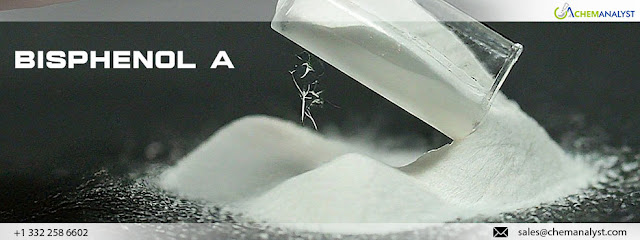Bisphenol A Prices, News, Trend, Graph, Chart, Monitor and Forecast
Bisphenol A (BPA) is a chemical compound widely used in the manufacturing of plastics and resins. It is primarily utilized in producing polycarbonate plastics and epoxy resins, which are essential in various industries such as automotive, electronics, construction, and food packaging. The price of Bisphenol A has been a subject of keen interest, particularly due to its extensive application in consumer products and the ongoing concerns about its environmental and health implications. Over recent years, the global Bisphenol A market has experienced significant fluctuations, influenced by multiple factors including raw material costs, regulatory pressures, supply-demand dynamics, and alternative product developments.
The global BPA market operates on a demand-supply basis, with China being the largest producer and consumer of this chemical. The country's rapid industrialization and large-scale manufacturing requirements contribute to its dominant position in the market. Other major markets for Bisphenol A include North America, Europe, and Japan. In these regions, the demand for BPA is primarily driven by the increasing need for durable plastics used in consumer electronics, automotive parts, and food packaging materials. Additionally, the rising adoption of BPA-based resins in coatings, adhesives, and paints has further bolstered market growth. However, the price of Bisphenol A is subject to fluctuations based on the availability of its primary raw material, phenol. Phenol prices play a crucial role in the overall production costs of BPA, and any disruptions in the supply chain or changes in global oil prices can significantly impact the cost structure of BPA production.
Get Real time Prices for Bisphenol A (BPA): https://www.chemanalyst.com/Pricing-data/bisphenol-a-29
In recent years, concerns about the harmful effects of Bisphenol A on human health and the environment have led to increasing regulatory scrutiny. Many countries have introduced regulations to limit the exposure of BPA in consumer products, particularly in food and beverage containers. As a result, several manufacturers are investing in the development of alternative chemicals to replace BPA, driving the demand for BPA-free materials. These regulatory challenges have put downward pressure on BPA prices, especially in regions where consumer health concerns are prominent. On the other hand, countries with less stringent regulations continue to see a steady demand for Bisphenol A, maintaining its price stability.
The increasing awareness regarding BPA’s potential to disrupt hormonal systems has led to growing consumer preference for BPA-free products, especially in food packaging, baby bottles, and medical devices. This shift in consumer preference has created a growing market for alternatives such as Bisphenol S (BPS) and Bisphenol F (BPF), although these alternatives are also being evaluated for their safety. Despite this growing interest in alternatives, Bisphenol A remains the most widely used compound due to its cost-effectiveness and versatility. However, as the demand for BPA-free products rises, manufacturers face the challenge of balancing consumer demands with production costs, which may result in price adjustments in the coming years.
The volatility of Bisphenol A prices is also influenced by global economic trends, such as inflation, trade policies, and geopolitical tensions. For instance, fluctuations in the global crude oil market can indirectly affect the cost of BPA, as the chemical is derived from petroleum-based products. Similarly, any disruptions in the supply chain, such as those caused by natural disasters or trade restrictions, can lead to temporary price hikes or shortages. In contrast, when oil prices stabilize, the cost of raw materials used in BPA production tends to decrease, which can lead to a reduction in its price.
Technological advancements in the production of Bisphenol A have also played a role in shaping market prices. Over the years, manufacturers have adopted more efficient and sustainable production processes, which help reduce production costs and improve overall profitability. These advancements have also contributed to increasing the availability of BPA, further influencing its price dynamics. Additionally, the ongoing research and development in the field of green chemistry have led to the exploration of bio-based alternatives to traditional BPA, potentially offering a more sustainable and cost-effective solution in the future.
In the coming years, the Bisphenol A market is expected to experience a complex pricing landscape, driven by the interplay of regulatory changes, consumer demand, and advancements in alternative materials. While the demand for BPA is likely to remain strong in certain industrial sectors, especially in developing countries, the growing trend toward sustainability and health-consciousness is expected to drive the adoption of BPA-free alternatives. This shift may result in a gradual decline in the overall demand for Bisphenol A, which could place downward pressure on its price. However, given its continued dominance in key applications, particularly in the automotive and electronics industries, the BPA market is not expected to face any immediate or drastic price declines.
Ultimately, the Bisphenol A price market is expected to remain volatile in the short term, with supply chain disruptions, regulatory challenges, and raw material costs playing pivotal roles in determining its future trends. Manufacturers will need to stay agile and adapt to changing market conditions, while also addressing the growing demand for safer and more sustainable products. As the market continues to evolve, industry players will need to carefully balance production costs, regulatory compliance, and consumer preferences to remain competitive in a rapidly changing landscape. Despite the challenges, Bisphenol A will continue to play a crucial role in global manufacturing, albeit with a greater emphasis on sustainability and health considerations, which will shape its price movements in the years ahead.
Get Real time Prices for Bisphenol A (BPA): https://www.chemanalyst.com/Pricing-data/bisphenol-a-29
Contact Us:
ChemAnalyst
GmbH - S-01, 2.floor, Subbelrather Straße,
15a Cologne, 50823, Germany
Call: +49-221-6505-8833
Email: sales@chemanalyst.com
Website: https://www.chemanalyst.com



%20Prices.JPG)
Comments
Post a Comment